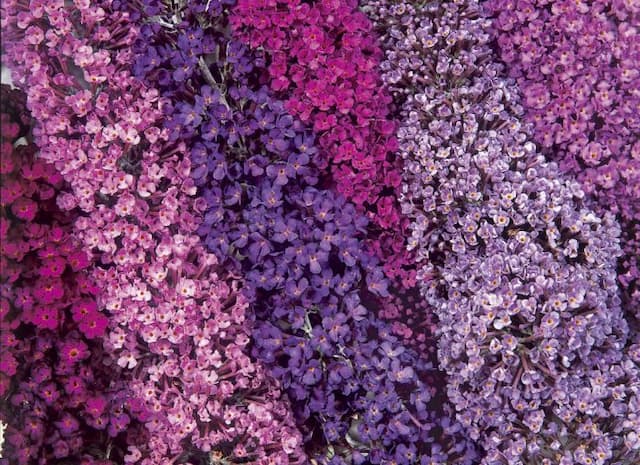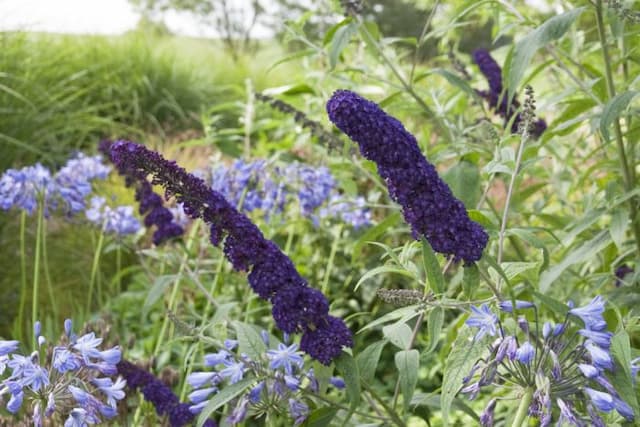Purple Mullein Verbascum phoeniceum 'Flush of White'

ABOUT
The plant commonly known as 'Flush of White' is a striking perennial that makes a notable impression with its distinctive color palette. One of its most charming features is its bloom—a collection of pure white flowers that are elegantly poised on top of slender stalks. These blooms exhibit a simplistic yet vibrant aesthetic, with each individual flower resembling a delicate cup shape. The foliage of 'Flush of White' is no less attractive. It is composed of a rosette of soft, green leaves that provide a lush backdrop for the white blossoms. The leaves are often covered in fine, short hairs which give them a slightly fuzzy texture. When the plant is not in bloom, these basal leaves form an attractive ground cover. Throughout its blooming period, which can span from late spring into summer, 'Flush of White' offers a whisper of serenity to the garden with its cool-toned flowers. It's a favored choice for gardeners looking to create a contrast with more vibrant plant varieties or for those seeking to design a white-themed garden area. The pure white flowers also have a penchant for attracting various pollinators, adding another layer of life and movement to the setting. Overall, 'Flush of White' presents a harmonious blend of foliage and flowers, with its delicate blossoms held aloft, creating a subtle yet captivating display that can enhance the beauty of any garden space.
About this plant
 Names
NamesFamily
Scrophulariaceae.
Synonyms
Purple Mullein, Temptress Purple, Phoenician Mullein, Flush of White.
Common names
Verbascum phoeniceum 'Flush of White'.
 Characteristics
CharacteristicsLife cycle
Biennials
Foliage type
Deciduous
Color of leaves
Green
Flower color
White
Height
3 feet (91 cm)
Spread
1 foot (30 cm)
Plant type
Herb
Hardiness zones
5
Native area
Europe
Benefits
 General Benefits
General Benefits- Aesthetic Appeal: Verbascum phoeniceum 'Flush of White', commonly known as the Purple Mullein, features striking white flowers that add elegance to any garden space.
- Attracts Pollinators: It attracts bees, butterflies, and other beneficial insects, supporting local ecosystems.
- Drought Tolerant: Once established, it is quite drought-resistant, making it ideal for xeriscaping and water-wise gardening.
- Low Maintenance: The plant requires minimal care once it's established, making it suitable for novice gardeners or those with limited time.
- Deer Resistant: Purple Mullein is known for being deer resistant, which is particularly beneficial in areas where deer predation is a problem.
- Seasonal Interest: It provides seasonal interest with its flowering spikes that soar above the foliage during late spring and early summer.
- Cold Hardy: This plant is capable of surviving and thriving in cooler climates, making it a versatile choice for gardens in temperate zones.
- Soil Adaptability: It can adapt to various soil types, although it prefers well-draining soil, making it suitable for different garden conditions.
- Uses in Landscape Design: Purple Mullein can be used in a variety of garden designs, including cottage gardens, rock gardens, and borders.
 Medical Properties
Medical Properties- Anti-inflammatory: Verbascum species have been traditionally used for their anti-inflammatory properties.
- Expectorant: Known to help in expelling mucus from the throat and lungs.
- Demulcent: Contains mucilage which can soothe irritated mucous membranes.
- Antibacterial: Some studies suggest Verbascum has antibacterial effects.
- Astringent: May be used for its tightening effect on the skin and mucous membranes.
 Air-purifying Qualities
Air-purifying QualitiesThis plant is not specifically known for air purifying qualities.
 Other Uses
Other Uses- Photography Prop: The Verbascum phoeniceum 'Flush of White', or Purple Mullein, with its striking white flowers, can be used by photographers as a natural prop to create beautiful and serene backgrounds for portraits and macro photography.
- Natural Dye: Purple Mullein can be used in natural dyeing processes to produce subtle colors on fabrics, although it is not a well-known source for dye.
- Crafts and Flower Arranging: The tall and sturdy flower spikes of Purple Mullein make them an excellent choice for dried floral arrangements and other craft projects requiring dried flowers.
- Garden Design: With its white blossoms, Purple Mullein is used to create a 'moon garden', where white-flowering plants are featured to glow during the night, creating a luminous landscape.
- Insectary Plant: Planting Purple Mullein in the garden can attract beneficial insects, like bees and butterflies, supporting biodiversity and helping with pollination of other plants.
- Educational Tool: Purple Mullein can be used as a teaching aid in horticulture and botany classes to illustrate plant growth, structure, and taxonomy.
- Sound Barrier: When planted in masses, the bushy form of Purple Mullein can help to muffle noise, making it a natural sound barrier in garden spaces.
- Support for Climbing Plants: The tall stems of Purple Mullein can serve as natural supports for climbing plants or vines in a garden setting.
- Photodegradation Study: Scientists can use Purple Mullein in studies to observe the breakdown of chlorophyll and other pigments, which might inform research on plant senescence and decay.
- Artistic Inspiration: The elegant form and pure white flowers of Purple Mullein often serve as inspiration for artists and sculptors, who might incorporate its likeness into various forms of artwork.
Interesting Facts
 Feng Shui
Feng ShuiThe Verbascum is not used in Feng Shui practice.
 Zodiac Sign Compitability
Zodiac Sign CompitabilityThe Verbascum is not used in astrology practice.
 Plant Symbolism
Plant Symbolism- Healing: Verbascum species have been used in traditional medicine for their anti-inflammatory properties.
- Protection: The thick leaves of Verbascum have traditionally been used to soothe and protect the skin, symbolizing shelter and safety.
- Light: The 'Flush of White' variety, with its bright white flowers, can symbolize clarity, purity, and the presence of light in darkness.
- Communication: Historically, Verbascum was believed to be associated with the voice and used in remedies for the throat, representing clear communication and expression.
 Water
WaterThe Purple Mullein should be watered when the top inch of the soil feels dry; typically, this could be about once a week during active growth periods, depending on weather conditions. Water the plant thoroughly, allowing it to penetrate deep into the soil, which encourages deep root growth. Depending on the size of the plant and the pot, this might mean using around one to two gallons of water for each watering session. In the dormant season, reduce watering to when the soil is dry a few inches down, to prevent overwatering and possible root rot. It's crucial not to leave the plant in standing water as these plants do not like soggy conditions.
 Light
LightThe Purple Mullein thrives best in full sun conditions, which means it requires at least 6 hours of direct sunlight daily to perform well. Place the plant in a location where it has unobstructed access to sunlight, such as a southern or western exposure in the Northern Hemisphere. While it can tolerate some partial shade, too much shade can reduce blooming and can cause the plant to become leggy as it stretches for light.
 Temperature
TemperatureThe Purple Mullein prefers temperatures between 60°F and 80°F for optimal growth; it is quite hardy and can survive minimum temperatures down to about 20°F. However, prolonged exposure to temperatures below freezing can be detrimental to the plant. During hot summer months, the plant can tolerate temperatures exceeding 80°F, but should be monitored for signs of heat stress such as wilting or leaf burn.
 Pruning
PruningPruning Purple Mullein is important to maintain its shape and to encourage more blooms. Deadhead spent flowers regularly throughout the blooming season to promote continuous flowering. If the plant becomes leggy or overgrown, cut it back by up to one third in early spring or after flowering to rejuvenate and encourage bushier growth. Pruning should be done with clean, sharp tools to prevent infection.
 Cleaning
CleaningAs needed
 Soil
SoilPurple Mullein, commonly known as Verbascum phoeniceum 'Flush of White', thrives in a well-draining soil mix with a slight alkalinity, aiming for a pH of 6.0 to 8.0. A mixture of loam, sand, and compost is ideal to provide both nutrition and good drainage.
 Repotting
RepottingPurple Mullein does not require frequent repotting and can often be left undisturbed for several years. Repot only when the plant has outgrown its current container, which typically happens every 2-3 years.
 Humidity & Misting
Humidity & MistingPurple Mullein prefers dry conditions and does not require high humidity. It is well-suited to the humidity levels found in most home environments.
 Suitable locations
Suitable locationsIndoor
Ensure full sun and well-draining soil for Purple Mullein indoors.
Outdoor
Plant in full sun with good drainage for outdoor Purple Mullein growth.
Hardiness zone
4-8 USDA
 Life cycle
Life cycleThe 'Flush of White', commonly known as Purple Mullein, begins its life cycle as a seed, which, when sown in well-draining soil and given appropriate warmth and moisture, germinates within two to three weeks. After germination, seedlings develop into a rosette of oval-shaped, slightly hairy leaves, characteristic of the first vegetative stage. This biennial plant will typically spend its first year growing foliage and establishing a strong root system. In its second year, Purple Mullein produces a tall flowering stalk, reaching up to 24 inches in height, adorned with pure white flowers that bloom from late spring to early summer. Following pollination by insects attracted to its flowers, the plant sets seed, completing its reproductive stage. The seeds are then dispersed, and the parent plant dies back, although it may produce offsets or self-seed under favorable conditions, ensuring the continuation of its life cycle.
 Propogation
PropogationPropogation time
Spring to Summer
The Verbascum phoeniceum, commonly known as 'Flush of White' mullein, is best propagated by seed. The ideal time to sow seeds is in late winter to early spring. Seeds should be surface sown, as they require light to germinate, onto a well-draining seed starting mix. Keep the soil moist but not waterlogged and place in a warm area with plenty of indirect sunlight. Germination can take anywhere from 14 to 30 days. Once the seedlings have grown sufficiently and the last frost has passed, they can be transplanted outdoors into a sunny spot with well-drained soil.


![Butterfly bush [Adonis Blue]](/_next/image?url=https%3A%2F%2Fplants-admin.emdemapps.com%2Fimages%2Fplants%2F%2Fimages%2F604b56e58f983.png&w=640&q=75)


![Butterfly bush [Buzz Ivory]](/_next/image?url=https%3A%2F%2Fplants-admin.emdemapps.com%2Fimages%2Fplants%2F%2Fimages%2F604b57987dfa8.png&w=640&q=75)
![Butterfly bush [Camberwell Beauty]](/_next/image?url=https%3A%2F%2Fplants-admin.emdemapps.com%2Fimages%2Fplants%2F%2Fimages%2F604b5ead04c12.png&w=640&q=75)


